Orientation for Success: Reflective Learning & Feedback in Education
VerifiedAdded on 2023/06/11
|8
|2296
|227
Essay
AI Summary
This essay explores the concept of reflective learning and its importance in achieving success in higher education. It discusses the use of feedback and feedforward approaches in both summative and formative assessments, emphasizing the role of self-assessment and continuous improvement. The essay also incorporates the Gibbs model as a tool for reflective practice, outlining its various stages for analyzing experiences and developing action plans. Furthermore, the text distinguishes between feedback and feedforward, highlighting their respective roles in guiding student growth and fostering a positive learning environment. Ultimately, the essay concludes that reflective learning, coupled with constructive feedback mechanisms, is crucial for students' academic and personal development, promoting self-awareness, critical thinking, and effective problem-solving skills. Desklib provides access to similar resources and solved assignments for students.
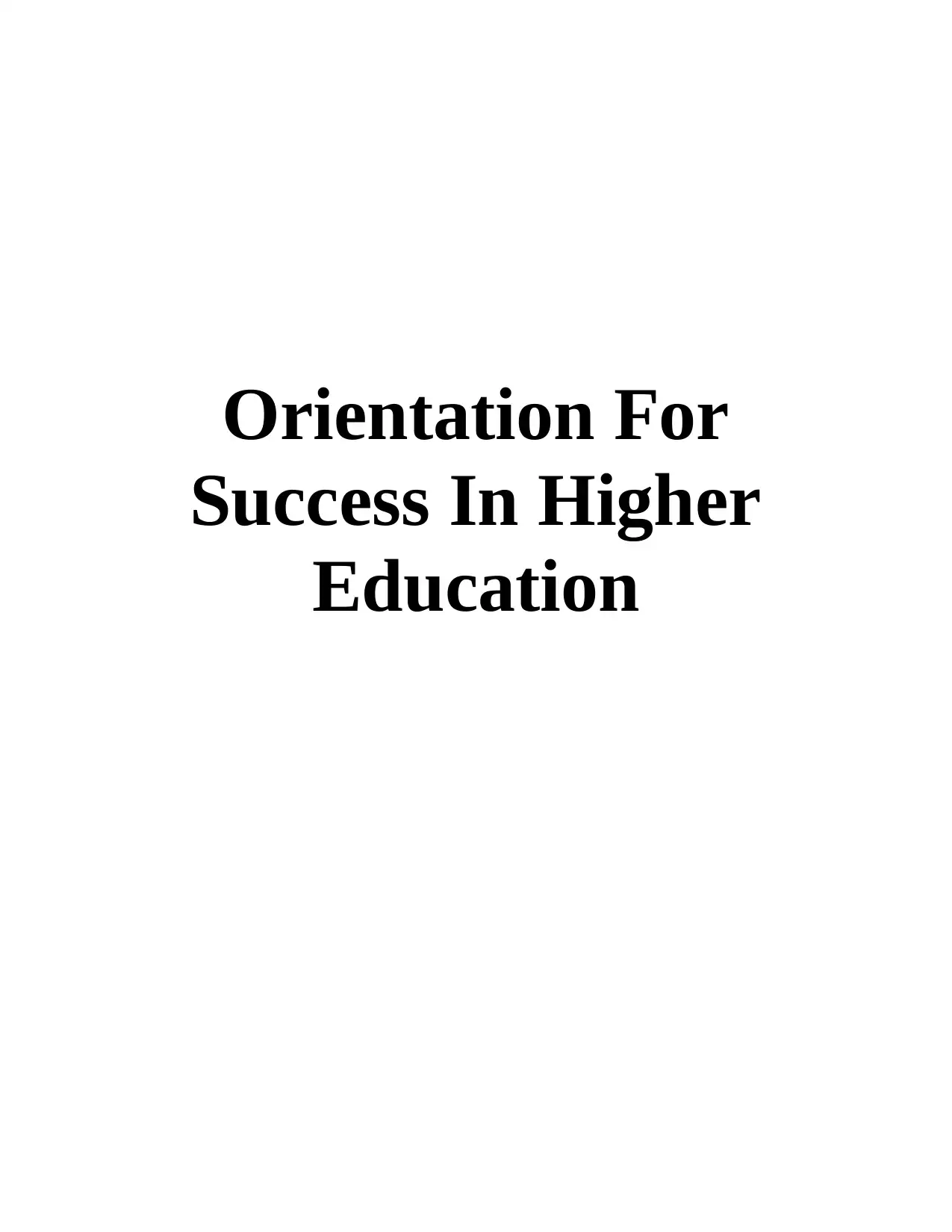
Orientation For
Success In Higher
Education
Success In Higher
Education
Paraphrase This Document
Need a fresh take? Get an instant paraphrase of this document with our AI Paraphraser
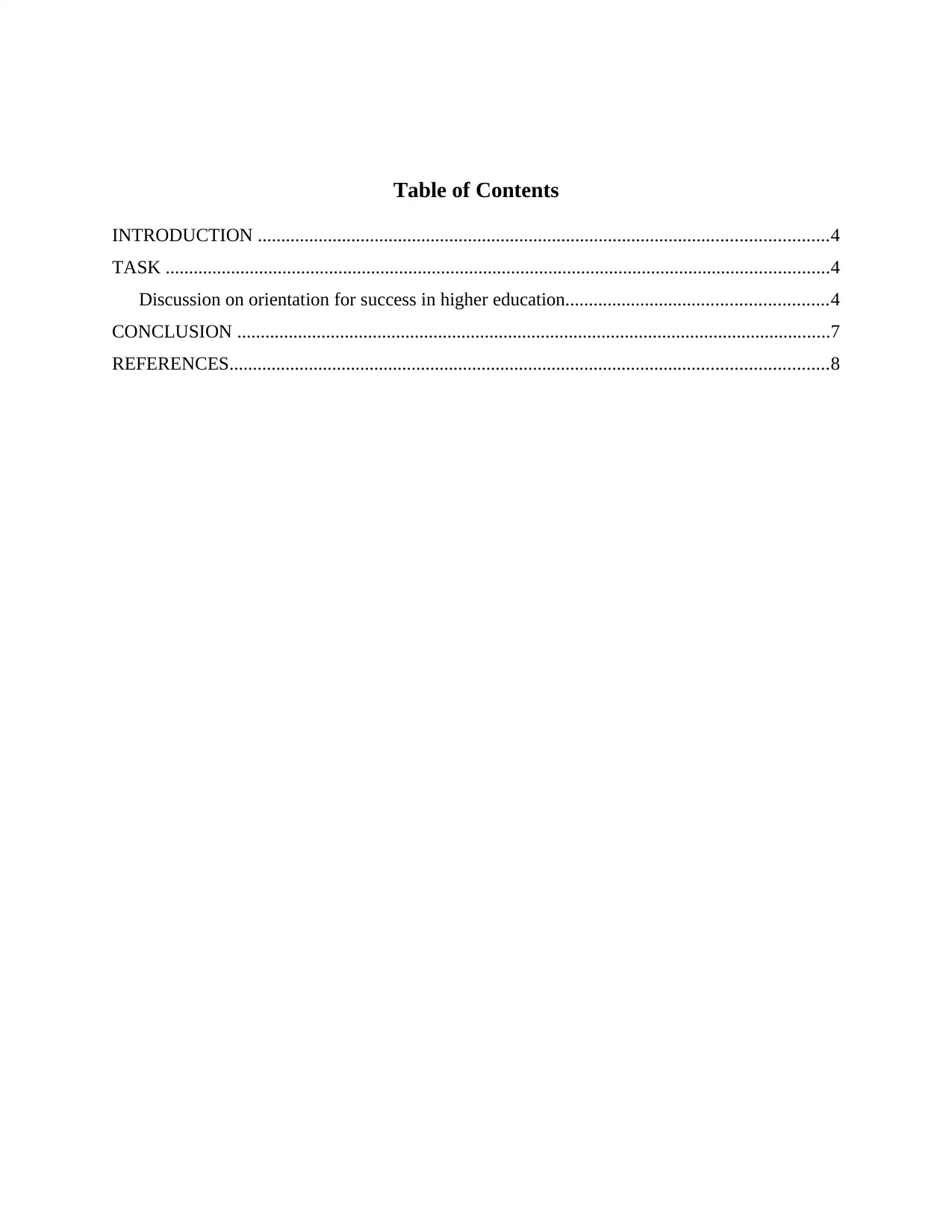
Table of Contents
INTRODUCTION ..........................................................................................................................4
TASK ..............................................................................................................................................4
Discussion on orientation for success in higher education........................................................4
CONCLUSION ...............................................................................................................................7
REFERENCES................................................................................................................................8
INTRODUCTION ..........................................................................................................................4
TASK ..............................................................................................................................................4
Discussion on orientation for success in higher education........................................................4
CONCLUSION ...............................................................................................................................7
REFERENCES................................................................................................................................8
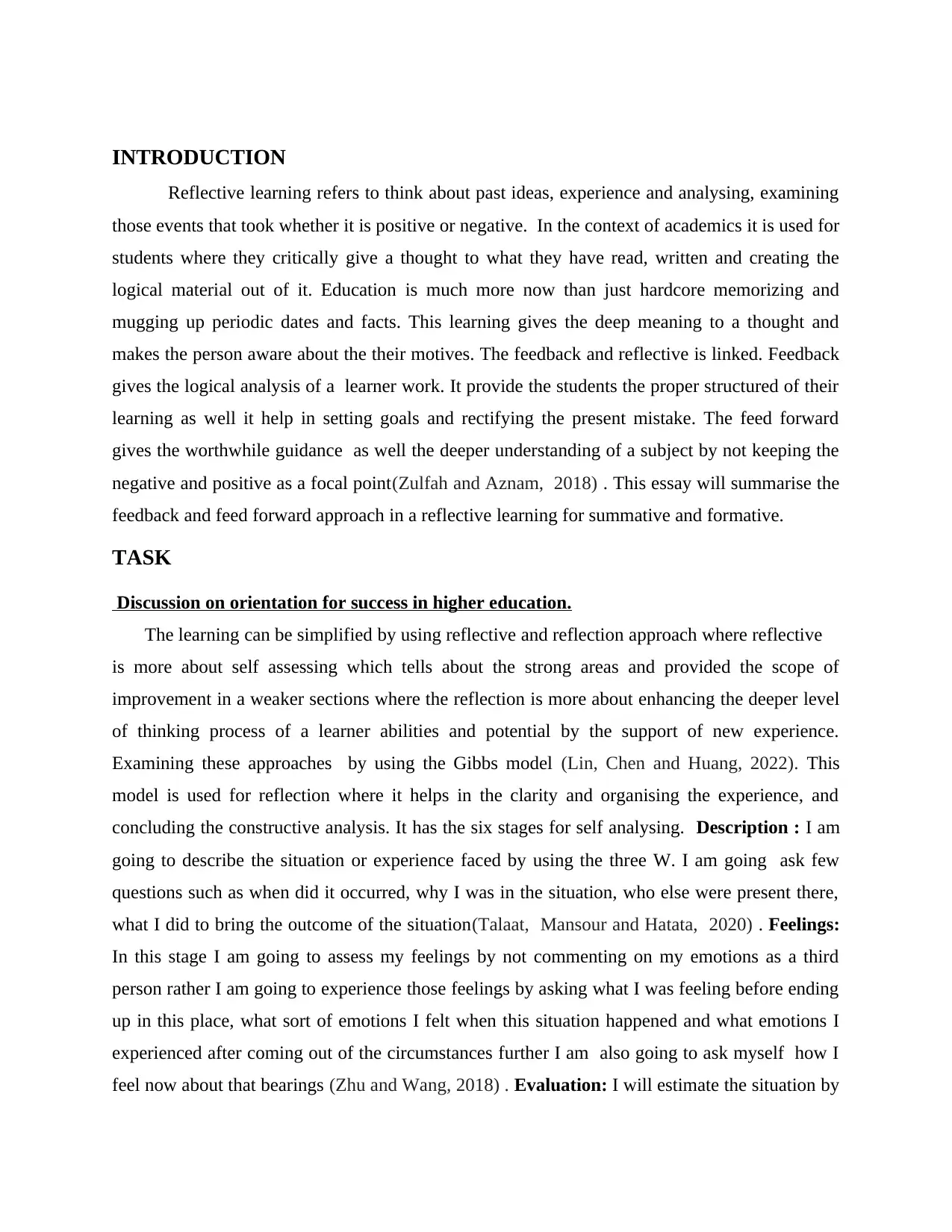
INTRODUCTION
Reflective learning refers to think about past ideas, experience and analysing, examining
those events that took whether it is positive or negative. In the context of academics it is used for
students where they critically give a thought to what they have read, written and creating the
logical material out of it. Education is much more now than just hardcore memorizing and
mugging up periodic dates and facts. This learning gives the deep meaning to a thought and
makes the person aware about the their motives. The feedback and reflective is linked. Feedback
gives the logical analysis of a learner work. It provide the students the proper structured of their
learning as well it help in setting goals and rectifying the present mistake. The feed forward
gives the worthwhile guidance as well the deeper understanding of a subject by not keeping the
negative and positive as a focal point(Zulfah and Aznam, 2018) . This essay will summarise the
feedback and feed forward approach in a reflective learning for summative and formative.
TASK
Discussion on orientation for success in higher education.
The learning can be simplified by using reflective and reflection approach where reflective
is more about self assessing which tells about the strong areas and provided the scope of
improvement in a weaker sections where the reflection is more about enhancing the deeper level
of thinking process of a learner abilities and potential by the support of new experience.
Examining these approaches by using the Gibbs model (Lin, Chen and Huang, 2022). This
model is used for reflection where it helps in the clarity and organising the experience, and
concluding the constructive analysis. It has the six stages for self analysing. Description : I am
going to describe the situation or experience faced by using the three W. I am going ask few
questions such as when did it occurred, why I was in the situation, who else were present there,
what I did to bring the outcome of the situation(Talaat, Mansour and Hatata, 2020) . Feelings:
In this stage I am going to assess my feelings by not commenting on my emotions as a third
person rather I am going to experience those feelings by asking what I was feeling before ending
up in this place, what sort of emotions I felt when this situation happened and what emotions I
experienced after coming out of the circumstances further I am also going to ask myself how I
feel now about that bearings (Zhu and Wang, 2018) . Evaluation: I will estimate the situation by
Reflective learning refers to think about past ideas, experience and analysing, examining
those events that took whether it is positive or negative. In the context of academics it is used for
students where they critically give a thought to what they have read, written and creating the
logical material out of it. Education is much more now than just hardcore memorizing and
mugging up periodic dates and facts. This learning gives the deep meaning to a thought and
makes the person aware about the their motives. The feedback and reflective is linked. Feedback
gives the logical analysis of a learner work. It provide the students the proper structured of their
learning as well it help in setting goals and rectifying the present mistake. The feed forward
gives the worthwhile guidance as well the deeper understanding of a subject by not keeping the
negative and positive as a focal point(Zulfah and Aznam, 2018) . This essay will summarise the
feedback and feed forward approach in a reflective learning for summative and formative.
TASK
Discussion on orientation for success in higher education.
The learning can be simplified by using reflective and reflection approach where reflective
is more about self assessing which tells about the strong areas and provided the scope of
improvement in a weaker sections where the reflection is more about enhancing the deeper level
of thinking process of a learner abilities and potential by the support of new experience.
Examining these approaches by using the Gibbs model (Lin, Chen and Huang, 2022). This
model is used for reflection where it helps in the clarity and organising the experience, and
concluding the constructive analysis. It has the six stages for self analysing. Description : I am
going to describe the situation or experience faced by using the three W. I am going ask few
questions such as when did it occurred, why I was in the situation, who else were present there,
what I did to bring the outcome of the situation(Talaat, Mansour and Hatata, 2020) . Feelings:
In this stage I am going to assess my feelings by not commenting on my emotions as a third
person rather I am going to experience those feelings by asking what I was feeling before ending
up in this place, what sort of emotions I felt when this situation happened and what emotions I
experienced after coming out of the circumstances further I am also going to ask myself how I
feel now about that bearings (Zhu and Wang, 2018) . Evaluation: I will estimate the situation by
⊘ This is a preview!⊘
Do you want full access?
Subscribe today to unlock all pages.

Trusted by 1+ million students worldwide
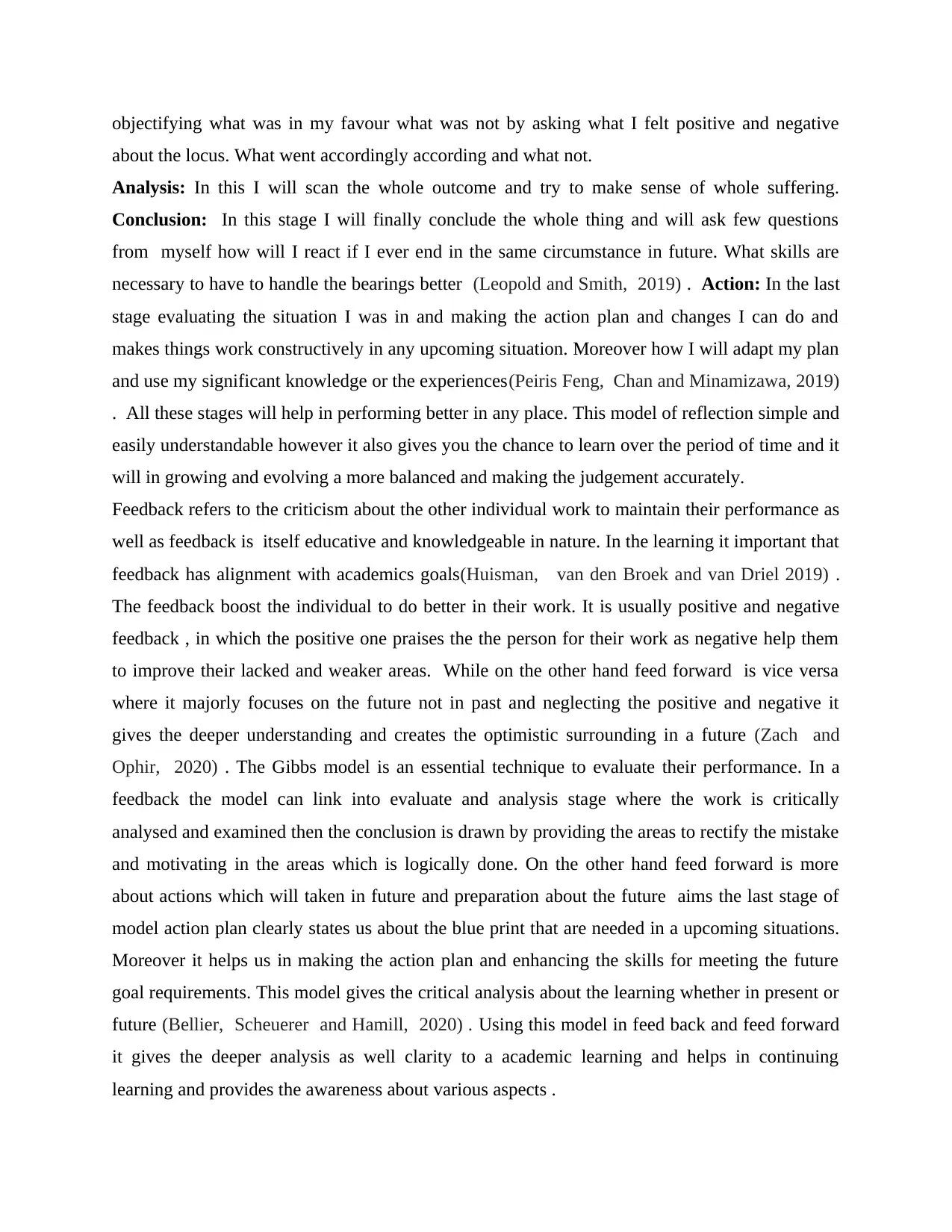
objectifying what was in my favour what was not by asking what I felt positive and negative
about the locus. What went accordingly according and what not.
Analysis: In this I will scan the whole outcome and try to make sense of whole suffering.
Conclusion: In this stage I will finally conclude the whole thing and will ask few questions
from myself how will I react if I ever end in the same circumstance in future. What skills are
necessary to have to handle the bearings better (Leopold and Smith, 2019) . Action: In the last
stage evaluating the situation I was in and making the action plan and changes I can do and
makes things work constructively in any upcoming situation. Moreover how I will adapt my plan
and use my significant knowledge or the experiences(Peiris Feng, Chan and Minamizawa, 2019)
. All these stages will help in performing better in any place. This model of reflection simple and
easily understandable however it also gives you the chance to learn over the period of time and it
will in growing and evolving a more balanced and making the judgement accurately.
Feedback refers to the criticism about the other individual work to maintain their performance as
well as feedback is itself educative and knowledgeable in nature. In the learning it important that
feedback has alignment with academics goals(Huisman, van den Broek and van Driel 2019) .
The feedback boost the individual to do better in their work. It is usually positive and negative
feedback , in which the positive one praises the the person for their work as negative help them
to improve their lacked and weaker areas. While on the other hand feed forward is vice versa
where it majorly focuses on the future not in past and neglecting the positive and negative it
gives the deeper understanding and creates the optimistic surrounding in a future (Zach and
Ophir, 2020) . The Gibbs model is an essential technique to evaluate their performance. In a
feedback the model can link into evaluate and analysis stage where the work is critically
analysed and examined then the conclusion is drawn by providing the areas to rectify the mistake
and motivating in the areas which is logically done. On the other hand feed forward is more
about actions which will taken in future and preparation about the future aims the last stage of
model action plan clearly states us about the blue print that are needed in a upcoming situations.
Moreover it helps us in making the action plan and enhancing the skills for meeting the future
goal requirements. This model gives the critical analysis about the learning whether in present or
future (Bellier, Scheuerer and Hamill, 2020) . Using this model in feed back and feed forward
it gives the deeper analysis as well clarity to a academic learning and helps in continuing
learning and provides the awareness about various aspects .
about the locus. What went accordingly according and what not.
Analysis: In this I will scan the whole outcome and try to make sense of whole suffering.
Conclusion: In this stage I will finally conclude the whole thing and will ask few questions
from myself how will I react if I ever end in the same circumstance in future. What skills are
necessary to have to handle the bearings better (Leopold and Smith, 2019) . Action: In the last
stage evaluating the situation I was in and making the action plan and changes I can do and
makes things work constructively in any upcoming situation. Moreover how I will adapt my plan
and use my significant knowledge or the experiences(Peiris Feng, Chan and Minamizawa, 2019)
. All these stages will help in performing better in any place. This model of reflection simple and
easily understandable however it also gives you the chance to learn over the period of time and it
will in growing and evolving a more balanced and making the judgement accurately.
Feedback refers to the criticism about the other individual work to maintain their performance as
well as feedback is itself educative and knowledgeable in nature. In the learning it important that
feedback has alignment with academics goals(Huisman, van den Broek and van Driel 2019) .
The feedback boost the individual to do better in their work. It is usually positive and negative
feedback , in which the positive one praises the the person for their work as negative help them
to improve their lacked and weaker areas. While on the other hand feed forward is vice versa
where it majorly focuses on the future not in past and neglecting the positive and negative it
gives the deeper understanding and creates the optimistic surrounding in a future (Zach and
Ophir, 2020) . The Gibbs model is an essential technique to evaluate their performance. In a
feedback the model can link into evaluate and analysis stage where the work is critically
analysed and examined then the conclusion is drawn by providing the areas to rectify the mistake
and motivating in the areas which is logically done. On the other hand feed forward is more
about actions which will taken in future and preparation about the future aims the last stage of
model action plan clearly states us about the blue print that are needed in a upcoming situations.
Moreover it helps us in making the action plan and enhancing the skills for meeting the future
goal requirements. This model gives the critical analysis about the learning whether in present or
future (Bellier, Scheuerer and Hamill, 2020) . Using this model in feed back and feed forward
it gives the deeper analysis as well clarity to a academic learning and helps in continuing
learning and provides the awareness about various aspects .
Paraphrase This Document
Need a fresh take? Get an instant paraphrase of this document with our AI Paraphraser
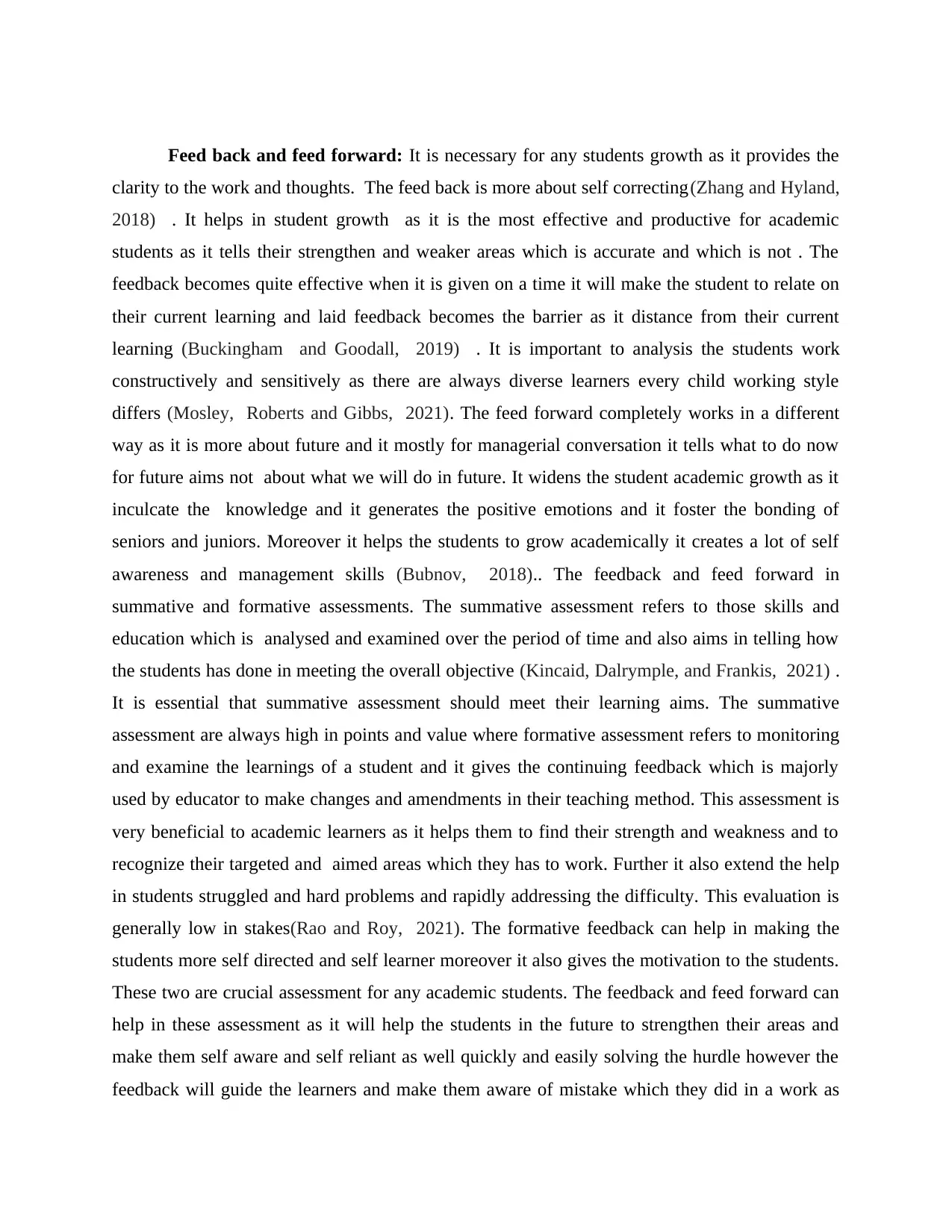
Feed back and feed forward: It is necessary for any students growth as it provides the
clarity to the work and thoughts. The feed back is more about self correcting(Zhang and Hyland,
2018) . It helps in student growth as it is the most effective and productive for academic
students as it tells their strengthen and weaker areas which is accurate and which is not . The
feedback becomes quite effective when it is given on a time it will make the student to relate on
their current learning and laid feedback becomes the barrier as it distance from their current
learning (Buckingham and Goodall, 2019) . It is important to analysis the students work
constructively and sensitively as there are always diverse learners every child working style
differs (Mosley, Roberts and Gibbs, 2021). The feed forward completely works in a different
way as it is more about future and it mostly for managerial conversation it tells what to do now
for future aims not about what we will do in future. It widens the student academic growth as it
inculcate the knowledge and it generates the positive emotions and it foster the bonding of
seniors and juniors. Moreover it helps the students to grow academically it creates a lot of self
awareness and management skills (Bubnov, 2018).. The feedback and feed forward in
summative and formative assessments. The summative assessment refers to those skills and
education which is analysed and examined over the period of time and also aims in telling how
the students has done in meeting the overall objective (Kincaid, Dalrymple, and Frankis, 2021) .
It is essential that summative assessment should meet their learning aims. The summative
assessment are always high in points and value where formative assessment refers to monitoring
and examine the learnings of a student and it gives the continuing feedback which is majorly
used by educator to make changes and amendments in their teaching method. This assessment is
very beneficial to academic learners as it helps them to find their strength and weakness and to
recognize their targeted and aimed areas which they has to work. Further it also extend the help
in students struggled and hard problems and rapidly addressing the difficulty. This evaluation is
generally low in stakes(Rao and Roy, 2021). The formative feedback can help in making the
students more self directed and self learner moreover it also gives the motivation to the students.
These two are crucial assessment for any academic students. The feedback and feed forward can
help in these assessment as it will help the students in the future to strengthen their areas and
make them self aware and self reliant as well quickly and easily solving the hurdle however the
feedback will guide the learners and make them aware of mistake which they did in a work as
clarity to the work and thoughts. The feed back is more about self correcting(Zhang and Hyland,
2018) . It helps in student growth as it is the most effective and productive for academic
students as it tells their strengthen and weaker areas which is accurate and which is not . The
feedback becomes quite effective when it is given on a time it will make the student to relate on
their current learning and laid feedback becomes the barrier as it distance from their current
learning (Buckingham and Goodall, 2019) . It is important to analysis the students work
constructively and sensitively as there are always diverse learners every child working style
differs (Mosley, Roberts and Gibbs, 2021). The feed forward completely works in a different
way as it is more about future and it mostly for managerial conversation it tells what to do now
for future aims not about what we will do in future. It widens the student academic growth as it
inculcate the knowledge and it generates the positive emotions and it foster the bonding of
seniors and juniors. Moreover it helps the students to grow academically it creates a lot of self
awareness and management skills (Bubnov, 2018).. The feedback and feed forward in
summative and formative assessments. The summative assessment refers to those skills and
education which is analysed and examined over the period of time and also aims in telling how
the students has done in meeting the overall objective (Kincaid, Dalrymple, and Frankis, 2021) .
It is essential that summative assessment should meet their learning aims. The summative
assessment are always high in points and value where formative assessment refers to monitoring
and examine the learnings of a student and it gives the continuing feedback which is majorly
used by educator to make changes and amendments in their teaching method. This assessment is
very beneficial to academic learners as it helps them to find their strength and weakness and to
recognize their targeted and aimed areas which they has to work. Further it also extend the help
in students struggled and hard problems and rapidly addressing the difficulty. This evaluation is
generally low in stakes(Rao and Roy, 2021). The formative feedback can help in making the
students more self directed and self learner moreover it also gives the motivation to the students.
These two are crucial assessment for any academic students. The feedback and feed forward can
help in these assessment as it will help the students in the future to strengthen their areas and
make them self aware and self reliant as well quickly and easily solving the hurdle however the
feedback will guide the learners and make them aware of mistake which they did in a work as
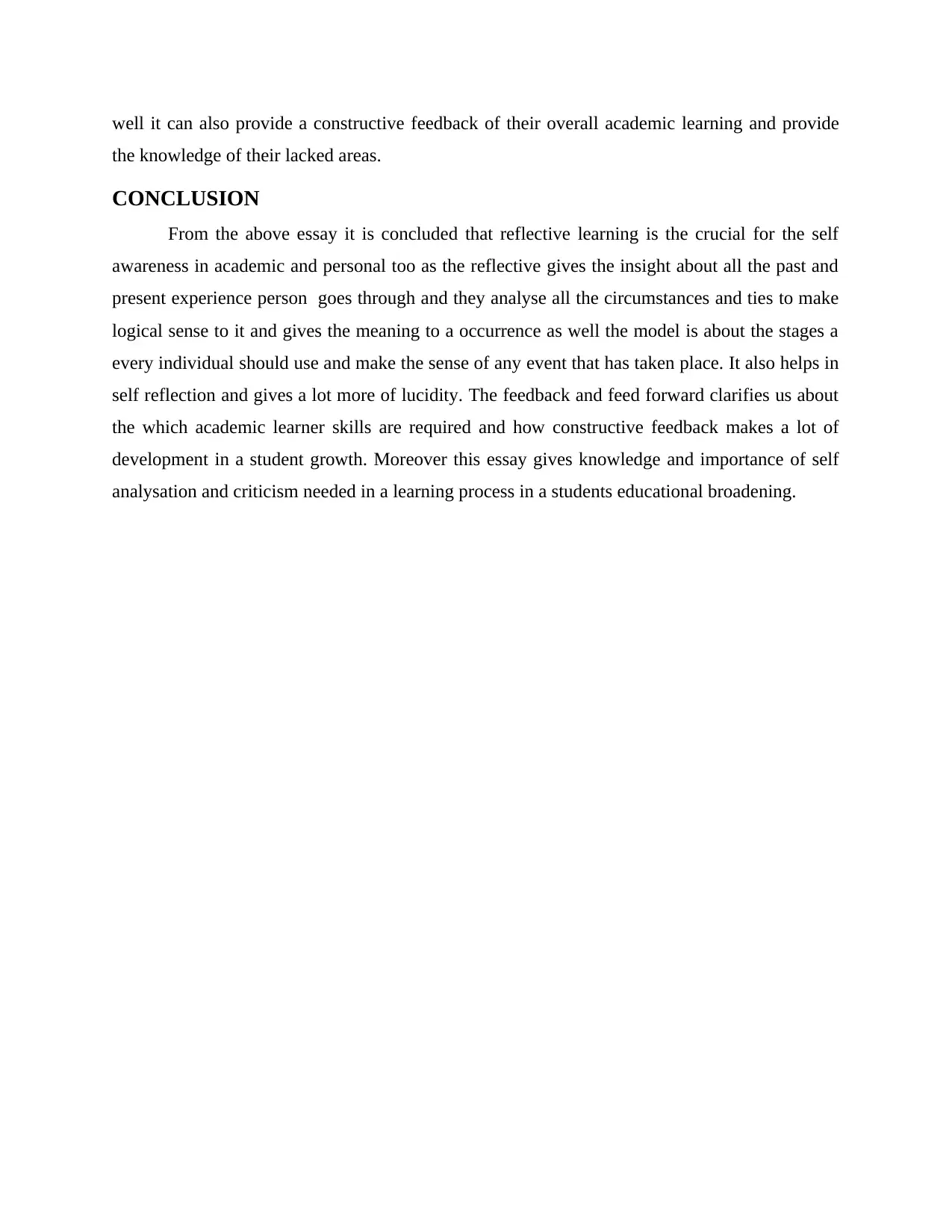
well it can also provide a constructive feedback of their overall academic learning and provide
the knowledge of their lacked areas.
CONCLUSION
From the above essay it is concluded that reflective learning is the crucial for the self
awareness in academic and personal too as the reflective gives the insight about all the past and
present experience person goes through and they analyse all the circumstances and ties to make
logical sense to it and gives the meaning to a occurrence as well the model is about the stages a
every individual should use and make the sense of any event that has taken place. It also helps in
self reflection and gives a lot more of lucidity. The feedback and feed forward clarifies us about
the which academic learner skills are required and how constructive feedback makes a lot of
development in a student growth. Moreover this essay gives knowledge and importance of self
analysation and criticism needed in a learning process in a students educational broadening.
the knowledge of their lacked areas.
CONCLUSION
From the above essay it is concluded that reflective learning is the crucial for the self
awareness in academic and personal too as the reflective gives the insight about all the past and
present experience person goes through and they analyse all the circumstances and ties to make
logical sense to it and gives the meaning to a occurrence as well the model is about the stages a
every individual should use and make the sense of any event that has taken place. It also helps in
self reflection and gives a lot more of lucidity. The feedback and feed forward clarifies us about
the which academic learner skills are required and how constructive feedback makes a lot of
development in a student growth. Moreover this essay gives knowledge and importance of self
analysation and criticism needed in a learning process in a students educational broadening.
⊘ This is a preview!⊘
Do you want full access?
Subscribe today to unlock all pages.

Trusted by 1+ million students worldwide
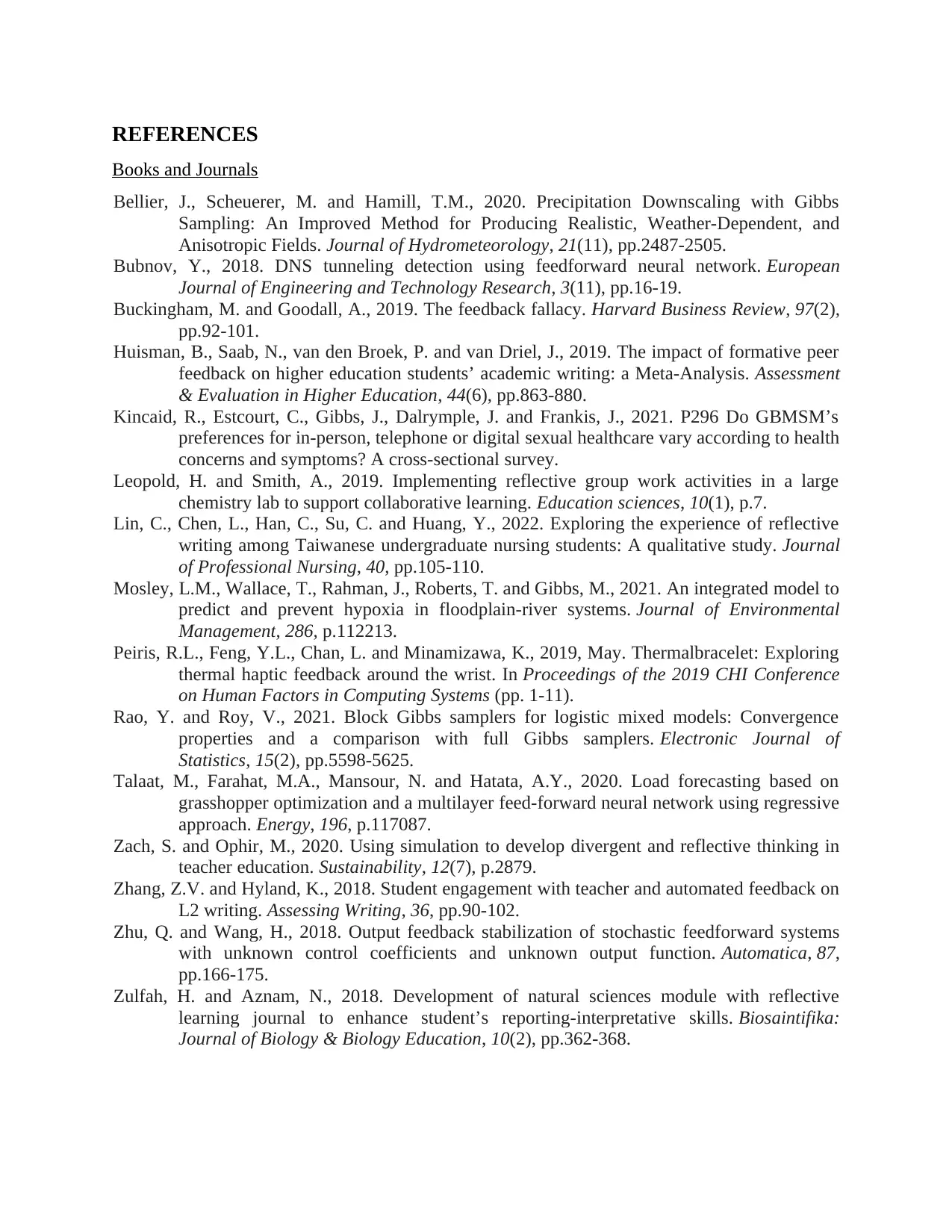
REFERENCES
Books and Journals
Bellier, J., Scheuerer, M. and Hamill, T.M., 2020. Precipitation Downscaling with Gibbs
Sampling: An Improved Method for Producing Realistic, Weather-Dependent, and
Anisotropic Fields. Journal of Hydrometeorology, 21(11), pp.2487-2505.
Bubnov, Y., 2018. DNS tunneling detection using feedforward neural network. European
Journal of Engineering and Technology Research, 3(11), pp.16-19.
Buckingham, M. and Goodall, A., 2019. The feedback fallacy. Harvard Business Review, 97(2),
pp.92-101.
Huisman, B., Saab, N., van den Broek, P. and van Driel, J., 2019. The impact of formative peer
feedback on higher education students’ academic writing: a Meta-Analysis. Assessment
& Evaluation in Higher Education, 44(6), pp.863-880.
Kincaid, R., Estcourt, C., Gibbs, J., Dalrymple, J. and Frankis, J., 2021. P296 Do GBMSM’s
preferences for in-person, telephone or digital sexual healthcare vary according to health
concerns and symptoms? A cross-sectional survey.
Leopold, H. and Smith, A., 2019. Implementing reflective group work activities in a large
chemistry lab to support collaborative learning. Education sciences, 10(1), p.7.
Lin, C., Chen, L., Han, C., Su, C. and Huang, Y., 2022. Exploring the experience of reflective
writing among Taiwanese undergraduate nursing students: A qualitative study. Journal
of Professional Nursing, 40, pp.105-110.
Mosley, L.M., Wallace, T., Rahman, J., Roberts, T. and Gibbs, M., 2021. An integrated model to
predict and prevent hypoxia in floodplain-river systems. Journal of Environmental
Management, 286, p.112213.
Peiris, R.L., Feng, Y.L., Chan, L. and Minamizawa, K., 2019, May. Thermalbracelet: Exploring
thermal haptic feedback around the wrist. In Proceedings of the 2019 CHI Conference
on Human Factors in Computing Systems (pp. 1-11).
Rao, Y. and Roy, V., 2021. Block Gibbs samplers for logistic mixed models: Convergence
properties and a comparison with full Gibbs samplers. Electronic Journal of
Statistics, 15(2), pp.5598-5625.
Talaat, M., Farahat, M.A., Mansour, N. and Hatata, A.Y., 2020. Load forecasting based on
grasshopper optimization and a multilayer feed-forward neural network using regressive
approach. Energy, 196, p.117087.
Zach, S. and Ophir, M., 2020. Using simulation to develop divergent and reflective thinking in
teacher education. Sustainability, 12(7), p.2879.
Zhang, Z.V. and Hyland, K., 2018. Student engagement with teacher and automated feedback on
L2 writing. Assessing Writing, 36, pp.90-102.
Zhu, Q. and Wang, H., 2018. Output feedback stabilization of stochastic feedforward systems
with unknown control coefficients and unknown output function. Automatica, 87,
pp.166-175.
Zulfah, H. and Aznam, N., 2018. Development of natural sciences module with reflective
learning journal to enhance student’s reporting-interpretative skills. Biosaintifika:
Journal of Biology & Biology Education, 10(2), pp.362-368.
Books and Journals
Bellier, J., Scheuerer, M. and Hamill, T.M., 2020. Precipitation Downscaling with Gibbs
Sampling: An Improved Method for Producing Realistic, Weather-Dependent, and
Anisotropic Fields. Journal of Hydrometeorology, 21(11), pp.2487-2505.
Bubnov, Y., 2018. DNS tunneling detection using feedforward neural network. European
Journal of Engineering and Technology Research, 3(11), pp.16-19.
Buckingham, M. and Goodall, A., 2019. The feedback fallacy. Harvard Business Review, 97(2),
pp.92-101.
Huisman, B., Saab, N., van den Broek, P. and van Driel, J., 2019. The impact of formative peer
feedback on higher education students’ academic writing: a Meta-Analysis. Assessment
& Evaluation in Higher Education, 44(6), pp.863-880.
Kincaid, R., Estcourt, C., Gibbs, J., Dalrymple, J. and Frankis, J., 2021. P296 Do GBMSM’s
preferences for in-person, telephone or digital sexual healthcare vary according to health
concerns and symptoms? A cross-sectional survey.
Leopold, H. and Smith, A., 2019. Implementing reflective group work activities in a large
chemistry lab to support collaborative learning. Education sciences, 10(1), p.7.
Lin, C., Chen, L., Han, C., Su, C. and Huang, Y., 2022. Exploring the experience of reflective
writing among Taiwanese undergraduate nursing students: A qualitative study. Journal
of Professional Nursing, 40, pp.105-110.
Mosley, L.M., Wallace, T., Rahman, J., Roberts, T. and Gibbs, M., 2021. An integrated model to
predict and prevent hypoxia in floodplain-river systems. Journal of Environmental
Management, 286, p.112213.
Peiris, R.L., Feng, Y.L., Chan, L. and Minamizawa, K., 2019, May. Thermalbracelet: Exploring
thermal haptic feedback around the wrist. In Proceedings of the 2019 CHI Conference
on Human Factors in Computing Systems (pp. 1-11).
Rao, Y. and Roy, V., 2021. Block Gibbs samplers for logistic mixed models: Convergence
properties and a comparison with full Gibbs samplers. Electronic Journal of
Statistics, 15(2), pp.5598-5625.
Talaat, M., Farahat, M.A., Mansour, N. and Hatata, A.Y., 2020. Load forecasting based on
grasshopper optimization and a multilayer feed-forward neural network using regressive
approach. Energy, 196, p.117087.
Zach, S. and Ophir, M., 2020. Using simulation to develop divergent and reflective thinking in
teacher education. Sustainability, 12(7), p.2879.
Zhang, Z.V. and Hyland, K., 2018. Student engagement with teacher and automated feedback on
L2 writing. Assessing Writing, 36, pp.90-102.
Zhu, Q. and Wang, H., 2018. Output feedback stabilization of stochastic feedforward systems
with unknown control coefficients and unknown output function. Automatica, 87,
pp.166-175.
Zulfah, H. and Aznam, N., 2018. Development of natural sciences module with reflective
learning journal to enhance student’s reporting-interpretative skills. Biosaintifika:
Journal of Biology & Biology Education, 10(2), pp.362-368.
Paraphrase This Document
Need a fresh take? Get an instant paraphrase of this document with our AI Paraphraser

1 out of 8
Related Documents
Your All-in-One AI-Powered Toolkit for Academic Success.
+13062052269
info@desklib.com
Available 24*7 on WhatsApp / Email
![[object Object]](/_next/static/media/star-bottom.7253800d.svg)
Unlock your academic potential
© 2024 | Zucol Services PVT LTD | All rights reserved.




